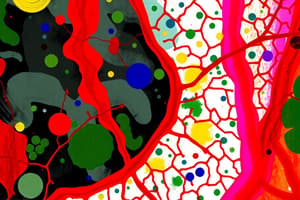Podcast
Questions and Answers
Explain the role of collagen in the extracellular matrix (ECM).
Explain the role of collagen in the extracellular matrix (ECM).
Collagen forms fibrils that give tissues strength, ensuring structural resilience.
What is the function of elastin in the ECM?
What is the function of elastin in the ECM?
Elastin imparts elasticity, allowing tissues to stretch and recoil.
Describe the contribution of fibronectin in the ECM.
Describe the contribution of fibronectin in the ECM.
Fibronectin plays a crucial role in cell adhesion, migration, and tissue development.
What are proteoglycans and how do they contribute to the ECM?
What are proteoglycans and how do they contribute to the ECM?
Explain the function of integrins in the ECM.
Explain the function of integrins in the ECM.
How does the ECM influence cellular behavior and maintain tissue integrity?
How does the ECM influence cellular behavior and maintain tissue integrity?
In what ways does collagen contribute to tissue structure and function in the ECM?
In what ways does collagen contribute to tissue structure and function in the ECM?
What role does elastin play in tissue function within the ECM?
What role does elastin play in tissue function within the ECM?
What are the major molecular components of the ECM?
What are the major molecular components of the ECM?
How do proteoglycans contribute to the ECM's properties?
How do proteoglycans contribute to the ECM's properties?
Explain the significance of integrins in cell-ECM interactions.
Explain the significance of integrins in cell-ECM interactions.
What is the function of fibronectin in the ECM?
What is the function of fibronectin in the ECM?
Explain the role of fibronectin in tissue development and repair.
Explain the role of fibronectin in tissue development and repair.
What is the function of proteoglycans with glycosaminoglycan (GAG) chains in the extracellular matrix (ECM)?
What is the function of proteoglycans with glycosaminoglycan (GAG) chains in the extracellular matrix (ECM)?
How do integrins facilitate cellular signaling and adhesion in tissue organization?
How do integrins facilitate cellular signaling and adhesion in tissue organization?
What processes are regulated by the interplay between ECM components and cells?
What processes are regulated by the interplay between ECM components and cells?
What is the role of cadherins in tissue integrity and organization?
What is the role of cadherins in tissue integrity and organization?
Explain the importance of selectins in immune cell recruitment and inflammation.
Explain the importance of selectins in immune cell recruitment and inflammation.
What are the functions of adhesion molecules in epithelial tissues?
What are the functions of adhesion molecules in epithelial tissues?
How can disruptions in adhesion lead to pathological conditions in epithelial tissues?
How can disruptions in adhesion lead to pathological conditions in epithelial tissues?
What are the key molecular processes involved in cellular signaling?
What are the key molecular processes involved in cellular signaling?
What roles do the MAPK pathway and Wnt signaling pathway play in cellular regulation?
What roles do the MAPK pathway and Wnt signaling pathway play in cellular regulation?
Flashcards are hidden until you start studying
Study Notes
Cell Adhesion and Signaling in Tissue Development and Maintenance
- Fibronectin, a glycoprotein, is crucial for cell adhesion and migration, essential for tissue development and repair.
- Proteoglycans, with glycosaminoglycan (GAG) chains, regulate tissue hydration levels and resist compressive forces in the extracellular matrix (ECM).
- Integrins, transmembrane proteins, link cells to the ECM, facilitating cellular signaling, adhesion, and migration, influencing tissue organization and function.
- The interplay between ECM components and cells regulates processes such as cell differentiation, proliferation, and apoptosis, impacting tissue development, homeostasis, and response to injury.
- Integrins are a prominent family of cell adhesion molecules, providing a physical link between the cell and the ECM and serving as signaling receptors.
- Cadherins are calcium-dependent cell adhesion molecules that mediate cell-cell adhesion through homophilic interactions and are crucial for tissue integrity and organization.
- Selectins, a family of cell adhesion molecules, mediate transient interactions between circulating blood cells and the endothelium, crucial for immune cell recruitment and inflammation.
- The IgSF includes diverse cell adhesion molecules such as ICAMs and VCAM-1, involved in leukocyte-endothelial cell interactions and immune responses.
- Adhesion molecules play a critical role in the structural integrity and physiological functions of epithelial tissues, including maintaining barrier function and tissue cohesion.
- Disruptions in adhesion can lead to compromised tissue integrity, impaired barrier function, and contribute to pathological conditions in epithelial tissues.
- Cellular signaling involves intricate molecular processes allowing cells to respond to external cues and coordinate their activities, often involving protein phosphorylation cascades.
- Signaling pathways like the MAPK pathway and Wnt signaling pathway play critical roles in regulating cell proliferation, differentiation, and tissue homeostasis.
Studying That Suits You
Use AI to generate personalized quizzes and flashcards to suit your learning preferences.




